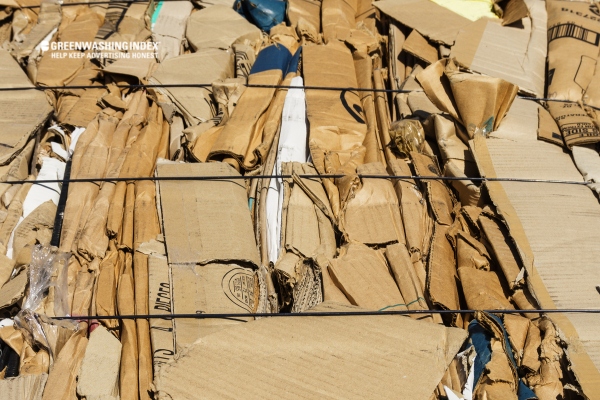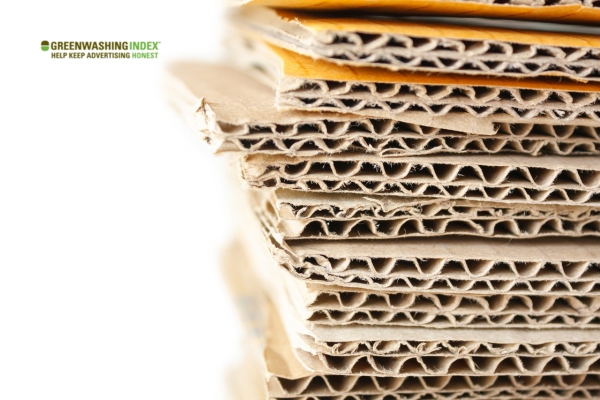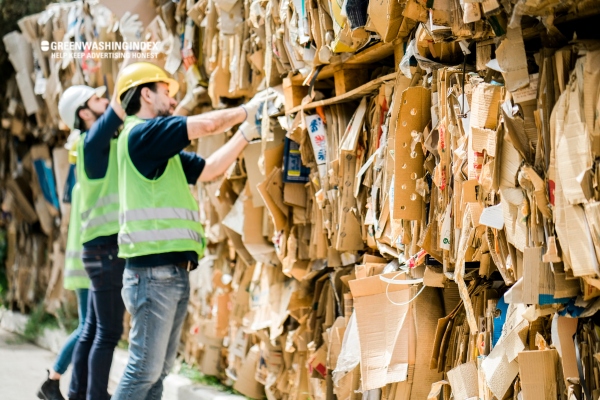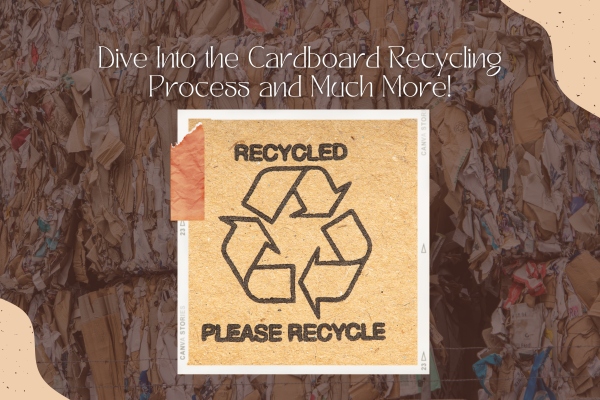It’s time we took recycling seriously, more specifically, cardboard recycling. Why, you might ask? Every time you toss out that cardboard box from your last online purchase in the trashcan instead of recycling it, not only are you contributing to the staggering amount of waste in landfills around the globe, but you are also missing out on an opportunity to save our Earth in a small yet significant way. Intriguing right?
Cardboard recycling is not rocket science; it’s a straightforward process that separates and collects waste cardboard materials and then transforms them back into new products through a series of industrial processing steps at a recycling facility. This process helps significantly reduce environmental pollution and also turns out to be economically beneficial for businesses!
Expect To Uncover:
- Fascinating facts about the positive environmental impacts of cardboard recycling.
- Interesting insights into how financial benefits come from this simple process.
- A step-by-step guide to effectively prepare your cardboard material for effective recycling.
- Tricks tackling common challenges encountered during this ecologically friendly journey.
- Intriguing uses for recycled cardboard that can inspire us all!
- Latest advancements aimed towards improving efficiency in this sector.
The Importance of Cardboard Recycling
Imagine a world where our trash doesn’t equate to massive landfill mountains or polluted oceans. This is possible, and the cardboard recycling process could be the key to achieving it.

Environmental Benefits
Cardboard recycling is not just an eco-friendly fad; it’s a substantial game-changer affecting our planet and our relationship with waste. Every time I recycle, I think about how my seemingly small action can significantly reduce the environmental impact of cardboard disposal. Remember that cardboard manufacturing uses trees as raw material, and by reusing them through recycling, we’re playing a vital role in forest conservation.
So why is this crucial in terms of sustainability? Well, get this: Recycling one ton of cardboard can save up to 17 trees! Yes, you heard that right. So, for those who query if their efforts matter in the grand scheme of things—trust me, it does! More importantly, it also helps decrease air pollution as manufacturing new cartons from recycled ones generates 25% less total waste.
Economic Advantages
Now let’s talk about money— dollar bills, moolah! Among the multiple benefits for businesses is cost reduction. Who isn’t looking into ways they can cut costs? With proper waste reduction strategies embracing sustainable packaging solutions like cardboard recycling, companies can lower their garbage disposal fees considerably since much less goes straight into the dumpster.
Beyond saving expenditures on trash management services alone, though, is revenue generation from selling off their recyclable materials in bulk quantities—an additional stream of income!
Have you ever imagined yourself actually making money out of your trash by incorporating this sustainability method? An interesting thought worth pondering over your evening cuppa!
Moreover, businesses adopting such eco-conscious practices are more appealing to customers who value social responsibility – giving them an advantageous edge over competitors.
So next time you’re holding a piece of cardboard—a shoe box or even a cereal packet—look at it twice. Remember, this simple, presumably inconsequential item has the potential to leave an immense environmental and economic impact through its recycling journey.
The Cardboard Recycling Process
Gradually, people are waking up to the potential benefits of recycling materials, and cardboard is no exception. What used to get routinely tossed away in the trash is now being recognized as a valuable resource. Digging into the nitty-gritty of the cardboard recycling process helps us understand why it’s worth advocating for.
Pre-Recycling Stage
The first step in the cardboard recycling process should start at home or within businesses – it’s all about separation and collection.
In most offices or homes where packaged goods are frequently received, it becomes vital to allocate a particular container strictly for storing discarded cardboard. This simple initiative ensures these recyclable materials don’t get intermingled with everyday household garbage.
For businesses dealing with voluminous wrapping materials or boxes, there are dedicated balers available in the market that press down and bundle large volumes of cardboard waste for easy transportation.
The collected cardboard then has to undergo a rigorous sorting phase. Based on its use, cardboard can be generally sorted out into two types: old corrugated containers (OCC) and boxboard/paperboard. OCC tends to be thicker and more rigid, while boxboards are thin – think cereal boxes or shoeboxes.
After sorting outcomes, ‘collection’, is typically carried out either by municipalities or private waste haulers who pick up these segregated cardboards from various locations and take them ahead in their journey toward getting recycled.
Industrial Processing
Moving forward from the pre-recycling stage brings us to processing facilities where the actual magic of transformation happens.
Upon entering an industrial recycling facility, collected cardboards undergo further sorting, removing any contaminants such as plastic film wrap or metal fasteners – absolutely anything considered non-recyclable based on established protocols will be weeded out.
Next comes squishing – literally! Piled-up cardboards get compacted through industrial-grade hydraulics, reducing their volume significantly and making them easier to handle. These compacted bales of cardboard are then soaked in a warm mixture of water and chemicals, breaking them down into a pulpy substance affectionately termed as ‘slurry.’
It’s this ‘Slurry’ that goes through a screening process wherein contaminants still present get filtered out. After multiple rounds of cleaning and de-inking (done via the floatation process), the pulp is ready for its transformation into new paper.
It gets sprayed onto large moving screens that shake to help water drainage and the formation of uniform paper layers. These are then heated, pressed, and finally rolled into gigantic paper rolls.
Thus, we can see how what was once a piece of discarded cardboard travels through myriad stages to become reincarnated as shiny new sheets of paper! This cardboard recycling process not only serves recycling benefits for businesses but also contributes significantly towards sustainable packaging solutions with remarkable environmental impact by waste reduction strategies.
Undoubtedly, understanding this entire lifecycle provides us with clear-cut insight as to why prioritizing recyclable materials like cardboard underpins our shared goal for an environmentally conscious world where we manage resources judiciously!
Tips for Effective Cardboard Recycling
Recycling cardboard doesn’t have to be a complex process. With some foreknowledge and a little bit of effort, you can make significant strides in your personal or business-related waste reduction strategies. Now, let’s dive into some practical preparation tips and discuss solutions for common recycling challenges.

Quick Preparation Guide
Properly preparing your cardboard for recycling is a crucial step in the entire cardboard recycling process. The right preparation not only ensures that the material isn’t rejected at the processing facility but also maximizes its future usability. So, here are easy-to-follow steps that you should consider:
- Separate:
Firstly, set apart your recyclable cardboard from other waste. Doing so facilitates easy collection and significantly minimizes contamination risks that might affect the quality of recycled output.
- Flatten:
Cardboard boxes should be flattened before they’re disposed of. This simple act reduces their volume, hence saving valuable storage space while awaiting pickup or delivery to recycling centers.
- Clean:
Another key tip is cleaning any residual food, oil stains, or other organic materials off your cardboard, as they can disrupt the recycling process due to biological decomposition.
- Bundle:
Lastly, neatly tie together your flattened and cleaned cardboard to simplify handling during transportation and subsequent processing stages.
Overcoming Common Challenges
While we strive to maintain a consistent cardboard recycling routine, some hitches are bound to occur along our sustainability journey. Here’s how you can navigate around such obstacles:
- Food Contaminated Cardboard:
You might find it challenging dealing with food-contaminated cardboard since they’re often deemed non-recyclable due to potential decay issues during storage periods prior to reuse processing. To combat this issue, scrape off as much food residue as possible before disposal.
- Waxed Cardboard Dilemma:
Waxed cardboard (commonly used in fruit boxes or some beverage packages) presents another significant challenge because of the complex nature of their recycling process. Though not all facilities accept them for recycling, you can do some research to identify facilities in your area that do.
- Differentiating Cardboard Types:
Sometimes, understanding which whole range of cardboard materials are recyclable can be tricky. To navigate this, familiarize yourself with the various cardboard types and their distinct properties. Bear in mind that corrugated cardboard (with a ruffled layer sandwiched between flat layers), paperboard (often used for things like cereal boxes), and unwaxed beverage cartons are generally recyclable.
By following these strategies, you can effectively reduce waste, contribute to positive environmental effects, and realize potential economic advantages from the cardboard recycling process.
Advanced Topics in Cardboard Recycling
Consider the landscape of cardboard recycling to be an ever-evolving one. As our understanding expands, innovative practices and cutting-edge tech come into play, giving rise to a whole new spectrum of possibilities.

Innovative Uses for Recycled Cardboard
The road doesn’t end at the recycling plant for cardboard; recycled cardboard can go on to lead several exciting lives! Through creative and sustainable packaging solutions, this recyclable material has permeated various industries due to its versatility. Here are some innovative uses:
- Garden Mulch: An excellent eco-friendly option, recycled cardboard is used as mulch in gardens. It’s safe for most plants and helps retain soil moisture while discouraging weeds.
- Eco-furniture: Several furniture makers now use fibers from recycled paper and cardboard to make durable chairs, tables—even lamps!
- Artistic Endeavors: From fashion accessories like earrings and belts to sculptures and wall decorations—recycled cardboard finds its place in many artists’ creations.
- Sustainable Packaging: Many businesses are replacing plastic packaging with recycled cardboard options, showing their commitment to waste reduction strategies.
In employing these novel applications, the environmental impact of cardboard disposal diminishes considerably.
Advances in Cardboard Recycling Tech
The potential scope of growth lies not only in the resourceful usage of recycled materials but also in the technological advancements within the recycling process itself. Let’s dissect some pioneering techniques enhancing efficiency within the industry:
- Robot Sorters: Advanced AI machines recognize different types of waste based on shape, size, color, or even texture – boosting sorting speed immensely.
- Near Infrared Technology (NIR): Offering swift identification of different materials at once—it speeds up sorting while maintaining a high level of accuracy.
- Ballistic Separators: These devices separate flat material (like paper or thin cardboard) from three-dimensional items using their unique movement system.
By embracing these cutting-edge advancements and exploring new applications, I firmly believe that we can shape a more sustainable future. Not only does this efficient cardboard recycling process reinforce our dedication to nature, but it also brings financial gains in the form of recycling benefits for businesses. To me, it’s clear – cardboard recycling is the key to unlocking infinite opportunities for both businesses and the environment.
FAQs
What types of cardboard are recyclable?
Almost all types of cardboard can be recycled. This includes corrugated cardboard, often used in boxes, as well as thinner paperboard materials like cereal boxes. The exception is waxed or food-contaminated cardboard, which requires special treatment.
How should I prepare my cardboard for collection?
Preparing your cardboard for recycling usually involves three simple steps: Flatten the boxes to save space, remove any plastic or non-paper materials from the box, and store them away from rain or liquid to avoid contamination.
How is recycled cardboard used?
Recycled cardboard can be remade into more packaging and paper products. It’s also increasingly being innovated for use in building materials and sustainable packaging solutions, contributing to an ecological evolution in numerous industries.
Conclusion
Cardboard recycling, though often underestimated, is a crucial element in our efforts toward sustainability and waste reduction. It greatly lessens the environmental impact of cardboard disposal by reducing the need for new raw materials.
Sustainable packaging solutions become the norm, benefiting not only businesses economically but also contributing to global waste reduction strategies. Furthermore, advancements in cardboard recycling tech offer new avenues to enhanced efficiency.
Key Takeaway Points:
- Emphasizing the importance of cardboard recycling for environmental and economic benefits.
- Understanding the cardboard recycling process from the pre-recycling stage to industrial processing.
- Adopting effective strategies for cardboard recycling, such as proper cleaning and flattening of materials.
- Overcoming common challenges like dealing with food-contaminated or waxed cardboard.
- Considering innovative uses for recycled cardboard fostering a circular economy.
- Keeping up with advances in cardboard recycling technology.



